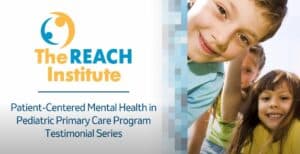Don’t panic about panic attacks
- February 24, 2023
- The REACH Institute
- Anxiety, Child mental health, Cognitive behavioral therapy

“The impairment from a panic attack doesn’t come from the episode itself,” said REACH faculty member James Wallace, MD. “It comes from the patient’s and family’s reaction.”
Dr. Wallace, a child and adolescent psychiatrist on the faculty of the University of Rochester Medical Center, describes panic episodes as “catastrophic emotional experiences.” Episodes are characterized by a burst of fear, racing heartbeat, hyperventilation, tunnel vision, sensations of choking, and more. “Patients feel like they’re going to explode, lose control, or even die,” said Dr. Wallace.
Single panic episodes are fairly common, particularly among patients with anxiety disorders. Panic disorder, characterized by several panic episodes over a period of time, affects about 2% of the population, usually starting in late adolescence or adulthood.
But even a single panic episode can have significant effects. “Patients become anxious about having another episode,” said Dr. Wallace. “So they start avoiding things.” For example, a child might want to stop attending school or going outdoors.
Caregivers often accidentally reinforce this fear. “If you witness a panic episode, it can be terrifying, as if your child is having a seizure,” Dr. Wallace noted. “Parents get scared and accommodate the child to avoid what they believe are triggers.”
Unfortunately, parents’ attempts to protect their child by keeping the child home from school or social activities can have significant developmental repercussions. The more the child avoids experiences, the more anxiety they feel and the more restrictions they need to feel safe. At its worst, the situation can spiral into social isolation and agoraphobia.
Dr. Wallace noted that some panic episodes have external triggers, while others come out of the blue. Either way, patients need support to face their fear and resume normal activities. Untreated panic episodes can worsen existing anxiety disorders and lead to other mental health concerns like depression, suicidal thoughts, and substance abuse.
Fortunately, pediatric primary care providers (PCPs) often can prevent this downward spiral. The PCP can offer education about the disorder and refer the child and family to evidence-based therapy. These early interventions can keep a single panic episode from becoming panic disorder.
“We always start with education,” said Dr. Wallace. “The first thing I say is that no one dies of a panic episode. It might feel like you will, but you won’t.” Dr. Wallace uses the metaphor of “brain freeze” from eating ice cream too fast. “That sensation feels like the end of the world, but, if you wait a few minutes, it goes away. Panic is like that. It’s a terrible feeling, but it goes away.”
Having one or even a few panic episodes doesn’t mean you’re crazy. It’s simply a misfiring of a system that everyone has. “It’s a false alarm evoking the fight-or-flight reaction when there’s no actual danger.” Normalizing the experience helps reduce the patient’s and family’s anxiety.
Before developing a plan for treatment, PCPs should conduct an assessment by taking a thorough history and family history, conducting a targeted physical exam, and using a validated tool such as SCARED or GAD-7. “I also talk to the child alone,” said Dr. Wallace. “They may have a magical theory or other misunderstandings they won’t share with their parents in the room.”
Evidence-based treatment for panic disorder includes cognitive behavioral therapy (CBT) with gradual exposure to triggering situations. Some children also benefit from a selective serotonin reuptake inhibitor (SSRI) like sertraline, escitalopram, or fluoxetine. The combination of CBT and medication is the most effective approach for severe cases.
“You may have to use a higher dosage of the SSRI than for some other disorders,” said Dr. Wallace. “But you can reassure the family that this medication has a good chance of drastically reducing the frequency and severity of future panic episodes.”
The next step is to help patients maintain normal activities or resume activities they are avoiding. CBT for panic involves helping patients become aware of thoughts that increase their anxiety and of the resulting body sensations. They learn to lessen their anxious thinking patterns and develop self-calming techniques. They can manage their anxiety instead of always avoiding things that make them anxious.
“The model of care for most children and teens with panic and severe anxiety involves a pediatrician coaching the parents and prescribing any needed medication, while a therapist guides the child and family in developing cognitive skills,” said Dr. Wallace. Not everyone has to see a child and adolescent psychiatrist, a rare resource in many communities.
If CBT is not readily available in your community, you can:
- Connect the family with virtual therapy.
- Recommend mindfulness and CBT apps, which can be effective for some patients.
- Take the REACH course CBT for Anxiety in Pediatric Primary Care so you can teach some CBT techniques yourself.
“Small interventions matter,” said Dr. Wallace. “If you can catch anxiety and panic early and teach patients how to breathe, self-soothe, and improve their sleep, these changes can have can have a huge impact.”
The trust families have in their PCP is a key ingredient of successful treatment. “You know your families! You often know which kids tend to be anxious and are more likely to develop panic episodes,” said Dr. Wallace. “You already have a therapeutic alliance with the family when they come in concerned about this terrifying episode. They can hear and believe you when you say, “We can treat this. You will be OK.”
RESOURCES
Dr. Wallace recommends the following resources from the American Academy of Child and Adolescent Psychiatry.
- For families: Panic Disorder in Children and Adolescents
- For families and clinicians: Anxiety Disorders Resource Center (scroll down for clinical resources)
- For clinicians: Clinical Practice Guideline for the Assessment and Treatment of Children and Adolescents With Anxiety Disorders
Categories
- ADHD
- Anti-racism
- Anxiety
- Assessment & screening
- Autism
- Child mental health
- Coding
- Cognitive behavioral therapy
- College transition
- Culturally responsive
- Depression
- Eating disorders
- Foster care
- Grief
- High-risk children & youth
- LGBTQIA
- Medication
- Parents
- Patient communication
- Pediatric primary care
- School refusal
- Sleep disorders
- Suicide
- Trauma
- Show All Categories
Register for courses
“The REACH Institute Video Testimonial: Jasmin  ”
”
